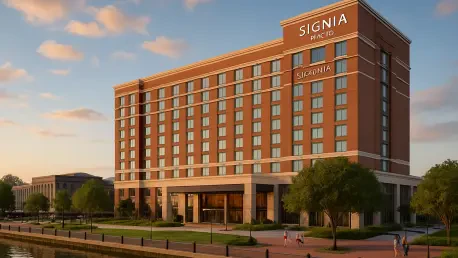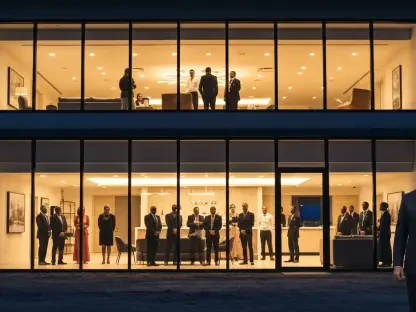Imagine a city on the cusp of transformation, where historic charm meets modern innovation, and a single development could redefine its status as a premier destination for business and leisure. Savannah, Georgia, is poised for such a shift with the groundbreaking of the 444-room Signia by Hilton Savannah, a convention hotel set to become the headquarters for the Savannah Convention Center. This project, announced for 2025, has sparked widespread interest among hospitality experts, local leaders, and industry analysts. This roundup gathers diverse perspectives, insights, and opinions on what makes this development a potential game-changer, comparing varying views on its impact, design, and economic promise.
Diverse Opinions on the Vision and Strategy
Hospitality industry observers have hailed the Signia by Hilton Savannah as a bold step in Hilton’s expansion into key urban markets with a focus on group travel. Many note that positioning the hotel as the central hub for the Savannah Convention Center reflects a strategic intent to capture the growing demand for event-based hospitality. Some analysts suggest that Hilton’s emphasis on integrating large-scale meeting facilities into its Signia brand demonstrates a forward-thinking approach to blending business and leisure travel in smaller yet significant cities like Savannah.
Contrasting opinions emerge regarding the scalability of this model. While a segment of industry watchers believes that targeting convention-centric properties will solidify Hilton’s dominance in Georgia—where it already operates around 270 hotels—others caution that over-reliance on group travel could expose vulnerabilities if market trends shift. A balanced view acknowledges that Hilton’s experience with similar projects, such as the recently opened Signia property in Atlanta, provides a strong foundation for navigating these risks while capitalizing on regional tourism growth.
Breaking Down the Impact: What Experts Are Saying
Cutting-Edge Design and Guest Experience
Feedback on the hotel’s design highlights its 34,000 square feet of meeting space, including a 13,000-square-foot ballroom, as a standout feature for large-scale events. Industry professionals commend the inclusion of smart room technology and locally inspired architecture, viewing these elements as essential for elevating the guest experience. Many draw parallels to the Atlanta Signia property, noting that such innovations set a high standard for convention hospitality by merging functionality with regional character.
However, some voices in the design and hospitality sectors express concerns about execution. There’s a shared apprehension that meeting the lofty expectations of convention attendees—particularly in terms of seamless technology integration—could prove challenging. A differing perspective emphasizes the importance of balancing modern amenities with authentic local touches, suggesting that Hilton must prioritize cultural resonance to avoid a generic, cookie-cutter feel in Savannah’s unique market.
A third viewpoint focuses on adaptability, with certain experts advocating for flexible spaces that can cater to diverse events, from corporate conferences to social gatherings. They argue that the hotel’s success will hinge on its ability to anticipate evolving needs, such as hybrid meeting formats, ensuring that the design remains relevant well beyond its planned opening in 2028.
Hilton’s Growing Presence in Georgia’s Tourism Scene
Analysts tracking Hilton’s portfolio expansion in Georgia see the Savannah project as a natural extension of the brand’s foothold, especially given its ties to major event hubs like the Georgia World Congress Center. Many agree that building on the success of the Atlanta Signia, which redefined convention hospitality in the state, positions Hilton to dominate the Southeast’s group travel market. The consensus is that this move strengthens the company’s competitive edge in a region ripe with tourism potential.
On the flip side, some market watchers highlight risks associated with saturation in the convention hotel niche. They point out that an influx of similar properties could dilute demand, particularly if economic conditions or travel patterns shift over the next few years. A contrasting opinion suggests that Savannah’s distinct appeal as a historic and cultural destination offers a buffer against such risks, providing Hilton with an opportunity to carve out a unique space in the market.
Additional insights focus on timing and long-term strategy. Certain industry voices argue that the 2028 opening timeline aligns well with projected growth in group travel, but they stress the need for Hilton to maintain momentum through targeted marketing and partnerships. This perspective underscores the importance of differentiating the Savannah property from competitors by leveraging Georgia’s diverse visitor base.
Group Travel Trends and Regional Dynamics
Emerging trends in group and event-based travel are a hot topic among hospitality thought leaders, with many positioning the Signia by Hilton Savannah as a timely response to rising demand for integrated convention facilities. Analysts note that Savannah’s growing reputation as a tourism and business destination makes it an ideal testing ground for such a project. There’s widespread agreement that this hotel could set a precedent for similar developments in smaller urban markets across the country.
Differing views arise on the broader implications for regional hospitality. Some experts speculate that the project might inspire a wave of innovation in how convention hotels are conceptualized, pushing brands to prioritize community integration over standardized designs. Others caution against overgeneralizing Savannah’s potential, arguing that its unique blend of history and modernity may not be easily replicable in other locales, thus limiting the model’s scalability.
A nuanced perspective focuses on customization, challenging the notion that convention hotels must follow a uniform blueprint. Several industry commentators praise Hilton’s tailored approach, suggesting that blending state-of-the-art offerings with local culture could redefine expectations for group travel infrastructure. They encourage other brands to take note of this strategy as a way to stand out in an increasingly competitive field.
Economic Benefits and Community Perspectives
Local stakeholders and economic analysts are buzzing with optimism about the potential ripple effects of the Signia by Hilton Savannah on the city’s tourism industry. Many community leaders emphasize the job creation and revenue boosts expected from the hotel operating at full capacity alongside the convention center. Their perspective aligns with broader industry views that large-scale hospitality projects often serve as catalysts for regional prosperity and upward mobility.
Comparative analyses from economic experts bring a different angle, drawing parallels to other major hospitality initiatives in urban centers. Some highlight that while the immediate benefits—such as increased visitor spending—are clear, the long-term impact depends on sustained collaboration between Hilton and local authorities. A few voices express mild skepticism, noting that promised economic gains sometimes fall short if infrastructure or marketing efforts lag behind.
A distinct opinion centers on the potential for replicable partnerships. Certain analysts suggest that this project could inspire a new standard for cooperation between global hospitality brands and municipal entities, fostering mutual growth. They argue that Savannah’s experience might encourage other cities to pursue similar ventures, amplifying the economic transformation narrative across diverse regions.
Strategic Takeaways from Varied Insights
Hospitality professionals and market analysts offer a range of actionable strategies based on the Signia by Hilton Savannah project. Many stress the importance of integrating hotels with convention centers to maximize event-driven revenue, viewing this as a key differentiator in crowded markets. Others advocate for heavy investment in localized guest experiences, arguing that cultural authenticity can create lasting impressions and foster repeat visits.
Additional tips focus on collaboration with local tourism boards to amplify visitor impact. Some experts recommend that businesses in Savannah—ranging from restaurants to tour operators—align their offerings with the hotel’s event calendar to capitalize on incoming traffic. A contrasting suggestion urges stakeholders to prioritize sustainability in operations, noting that eco-friendly practices could enhance the project’s appeal to modern travelers and corporate clients.
There’s also a call for continuous adaptation, with several voices encouraging Hilton and similar brands to stay ahead of technological and design trends. They propose regular assessments of guest feedback and market shifts to ensure the property remains competitive. This collective wisdom underscores the need for a dynamic approach to hospitality development in evolving urban landscapes.
Reflecting on a Transformative Milestone
Looking back on the discussions surrounding the Signia by Hilton Savannah, it becomes evident that this project has sparked a rich dialogue among industry experts, local leaders, and analysts. The diverse opinions highlight both the immense potential and the nuanced challenges of redefining convention hospitality in a city like Savannah. Each perspective contributes to a deeper understanding of how strategic design, economic collaboration, and regional dynamics intertwine to shape this initiative.
For those eager to build on these insights, a practical next step involves exploring partnerships with local entities to enhance visitor experiences and economic outcomes. Industry players are encouraged to monitor the project’s progress through 2028, using it as a case study for balancing innovation with authenticity. Additionally, delving into broader trends in group travel offers a pathway to anticipate future shifts, ensuring that stakeholders remain agile in a competitive landscape.









